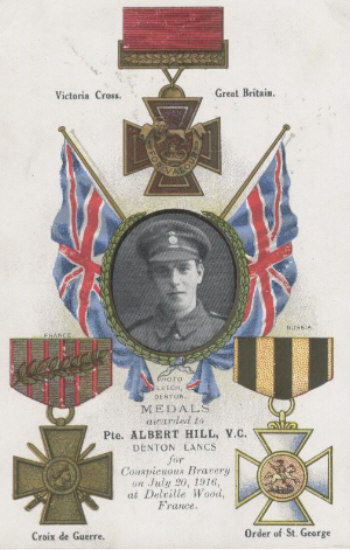|
Albert Hill VC
(1895-1971)
Albert Hill was born in Hulme on 24th May 1895, one of ten children. In 1907 his family moved to live in Peacock Street in Denton. After leaving school he began work at the Alpha Mill and then became an apprentice planker at Wilson Hat Manufacturers on Wilton Street.
At the outbreak of the First World War, Hill enlisted in the 10th Battalion of the Royal Welsh Fusiliers, with whom he served in France and Flanders. He was awarded the Victoria Cross for his gallantry and "...most conspicuous bravery".
On 20 July 1916, during the Battle of the Somme, Private Hill's battalion advanced under heavy gunfire to assault an enemy position in Delville Wood. When the order to charge was given Hill confronted two German soldiers and bayoneted them both. However, finding himself cut off from the rest of his battalion in the confusion, and, being surrounded by the enemy, he fought them off with hand grenades, killing and wounding about eighteen and scattering the remainder. He then rejoined his company and fought his way back to the lines.
Later, on discovering that his Company Officer and a scout were lying wounded in no man's land, he went out, without any thought of his own safety and helped bring in the mortally wounded Officer, two other men bringing in the scout. Finally, Hill single-handedly captured two enemy soldiers and took them prisoner.
Hill returned to Denton as a public hero in October 1916. In November he was awarded the Victoria Cross by King George V at Buckingham Palace. He was also awarded the Croix de Guerre and the Russian Cross of St George of the First Class and three campaign medals.
In February 1919, Hill returned to work at Wilson's Factory. He and his wife lived in Denton until 1923, when they emigrated to the United States.
In 1956 Hill made a brief return to England for the VC Centenary Celebrations. He died 17th February 1971 and was buried with full military honours at Highland Memorial Cemetery in Johnston, Rhode Island. His medal is in the Royal Welsh Fusiliers Regimental Museum.
|

